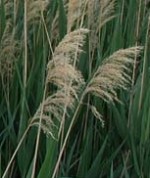 Native to temperate wetlands world wide, this perennial aquatic grass is a member of the grass family, Poaceae, that also includes corn, rice, and bamboo. It is a vigorous grower and can form extensive stands in damp ground, standing in water 3′ deep, or as a floating mat. With thick, long, unbranched rhizomes, common reed grows up to twenty feet tall and has a leafy, hollow, unbranched stem. The broad, flat leaf blades are green to grayish green, deciduous, seven to twenty four inches long, and have rough margins. The purplish flowers are carried in large feathery highly branched panicles six to twenty inches long from mid-summer to fall. As the panicles mature they develop long, silky hairs and appear gray. Common reed is used for many purposes including food, fodder, medicine, thatch, weaving material, paper, and dried flower arrangements. Because of their vigorous rapid growth plants may become invasive but can be controlled in grasslands by regular grazing of livestock. In addition, common reed is tolerant of alkaline and brackish conditions and may become invasive in marshes and estuaries. The genus name, Phragmites, comes from the Greek word phragma meaning hedge and refers to its growth habit. The specific epithet, australis, is from the Latin word auster meaning south wind i.e. the southern country.
Native to temperate wetlands world wide, this perennial aquatic grass is a member of the grass family, Poaceae, that also includes corn, rice, and bamboo. It is a vigorous grower and can form extensive stands in damp ground, standing in water 3′ deep, or as a floating mat. With thick, long, unbranched rhizomes, common reed grows up to twenty feet tall and has a leafy, hollow, unbranched stem. The broad, flat leaf blades are green to grayish green, deciduous, seven to twenty four inches long, and have rough margins. The purplish flowers are carried in large feathery highly branched panicles six to twenty inches long from mid-summer to fall. As the panicles mature they develop long, silky hairs and appear gray. Common reed is used for many purposes including food, fodder, medicine, thatch, weaving material, paper, and dried flower arrangements. Because of their vigorous rapid growth plants may become invasive but can be controlled in grasslands by regular grazing of livestock. In addition, common reed is tolerant of alkaline and brackish conditions and may become invasive in marshes and estuaries. The genus name, Phragmites, comes from the Greek word phragma meaning hedge and refers to its growth habit. The specific epithet, australis, is from the Latin word auster meaning south wind i.e. the southern country.
Type: Herbaceous perennial warm weather grass
Bloom: Highly branched, feathery panicles, 6-20″ long, of purplish flowers from mid-summer to fall.
Size: 20′ H
Light: Full sun to partial shade
Soil: Average, wet to damp; tolerant of alkaline and saline conditions
Hardiness: Zones 4-8
Care: Control spread.
Pests and Diseases: Susceptible to damage by insects, fungi and bacteria
Propagation: Division of rhizomes
Companion Plants: Cattail, white panicle aster, northern bayberry
Outstanding Selections: Unknown
Photo Credit: Wikipedia